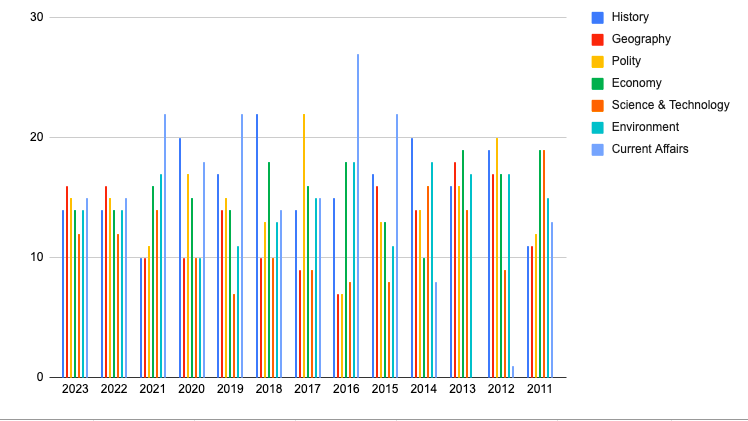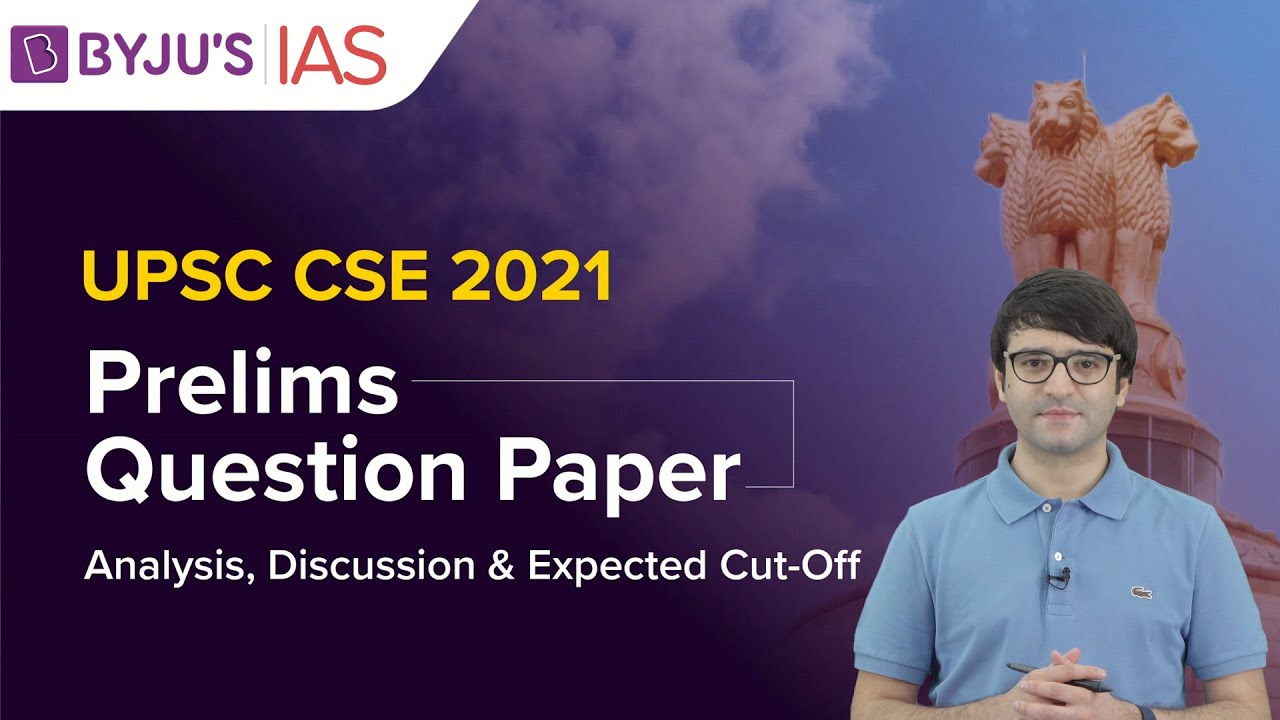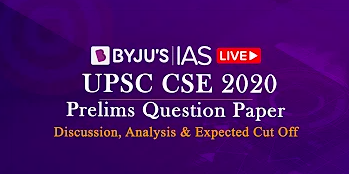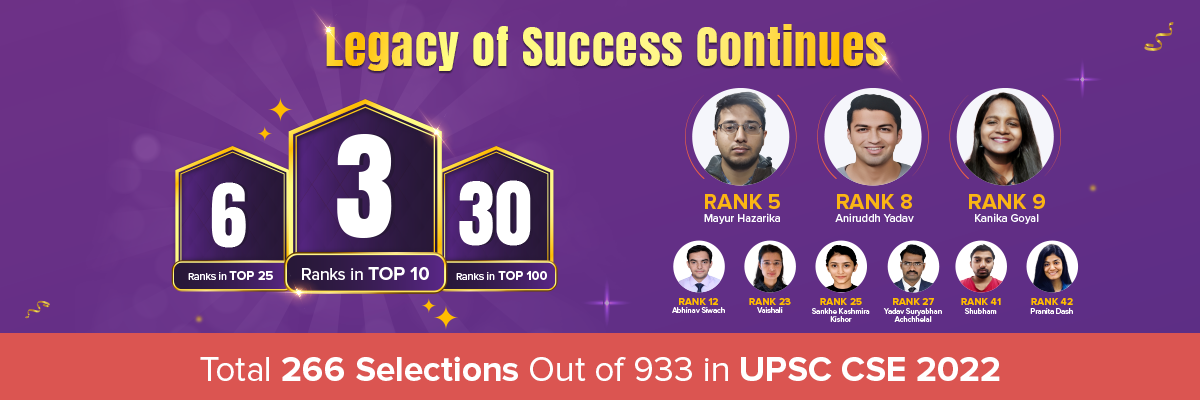The UPSC Civil Services Prelims exam 2024 will be conducted on 26th May 2024. Lakhs of aspirants will appear for the exam in the hope of realising their IAS dreams.
The UPSC Prelims is the first step towards making a career in the prestigious Civil Services of India. The Civil Services Exam is a three-stage exam consisting of a preliminary exam, mains exam, and interview.
Explore the Ultimate Guide to IAS Exam Preparation
Download The E-Book Now!
In this article, aspirants can find trend analysis of UPSC Prelims along with marks distribution from 2011 to 2023 and videos of paper analysis. The UPSC Prelims Syllabus comprises multiple topics under different subjects and reviewing the exam analysis can be of great help in apprehending the important topics.
UPSC Prelims Pattern and Syllabus
The IAS prelims exam round consists of two papers. The Prelims is essentially an eliminating round in which, from about 5 lakh people (on average) who take the exam, only about 10 – 15 thousand clear it. The marks secured in this exam decide whether aspirants can go on to the next stage or not. It is important to prepare well and have a comprehensive understanding of the subjects covered in this exam. In this article, we bring you an analysis of the trends in marks distribution according to various subjects covered in the exam over the past decade.
The prelims papers consist of objective type questions with negative marking for incorrect answers. The structure of the prelims exam is as follows:
| Paper | Total Marks | No. of Questions | Duration | Type | Negative Marks | Nature |
| General Studies Paper 1 | 200 | 100 | 2 hours | Objective | Yes | Merit Ranking |
| General Studies Paper 2 (CSAT) | 200 | 80 | 2 hours | Objective | Yes | Qualifying |
UPSC Prelims Syllabus:
| General Studies Paper I | General Studies Paper II |
| Current events of national and international importance. | Comprehension |
| History of India and Indian National Movement | Interpersonal skills including communication skills |
| Indian and World Geography-Physical, Social, Economic | Logical reasoning and analytical ability |
| Geography of India and the World | Decision making and problem-solving |
| Indian Polity and Governance-Constitution | General mental ability |
| Political System, Panchayati Raj, Public Policy, Rights Issues, etc. | Basic numeracy (numbers and their relations, orders of
Magnitude, etc.) (Class X level), Data interpretation (charts, graphs, tables, data sufficiency etc. — Class X level) |
| General issues on Environmental ecology, Biodiversity
and Climate Change – that do not require subject specialization |
|
| Economic and Social Development-Sustainable | |
| Development, Poverty, Inclusion, Demographics, Social | |
| Sector Initiatives, etc. | |
| General Science |
Candidates need to secure at least 33% in the General Studies Paper II and it is compulsory to attempt both the papers to be eligible for evaluation. The candidates who secure at least the minimum cut off marks for General Studies I and qualify in General Studies II are invited to appear in the UPSC Mains exam.
After analysing the prelims examination, candidates must also review the UPSC Mains Syllabus, as a key criterion for evaluating the final merit of the marks scored in the mains examination.
About the UPSC Prelims Cut off Marks:
The prelims cut off marks refer to the minimum marks required in the GS Paper I to qualify for the mains (provided candidates score at least 33% in the CSAT). This cut off mark changes every year depending upon the performance of the candidates and the number of vacancies.
Read more about UPSC cut off marks here.
UPSC Prelims-related booklist
The preliminary examination is an objective-type examination with two papers:
- General Studies Paper 1
- CSAT
The Commission decides UPSC Cut Off based on the marks acquired in the General Studies Paper 1 of this examination. CSAT is a qualifying examination where a candidate has to score a minimum of 33% of the total marks (200). Marks acquired in both the papers are not considered while making the final merit list of the examination, i.e in the final IAS result.
Before coming to the list of books that are a part of the prelims preparation, candidates must know the following points:
- NCERT syllabus is fundamental to the exam preparation irrespective of the stage of the examination.
- Revision is the key to success. Sooner aspirants accept this, better are the chances to crack the exam.
- Take mock tests sincerely and learn from the feedback.
Booklist for UPSC Preliminary Exam
Candidates can find the list of books with their subjects needed for the IAS Prelims examination below:
| Subject | Books |
| History | NCERT Class 11th and 12th, or
Tamil Nadu State Board Text Books of Class 11th and 12th |
| Indian Polity | NCERT Class 12th – Politics in India Since Independence
M.Laxmikanth’s Indian Polity |
| Human Geography, Physical Geography and World Geography | NCERT Class 6th to 12th
G C Leong’s Certificate Physical and Human Geography |
| Indian Economy | NCERT Class 11th and 12th
Ramesh Singh’s Indian Economy |
| Environment and Ecology | NCERT Class 12th Biology [Last 4 Chapters]
NCERT Class 11th Geography Majid Hussain’s Environment and Ecology – Biodiversity, Climate Change and Disaster Management |
| Science and Technology | NCERT Class 6th to 10th Science Books |
| Art & Culture | NCERT Class 11th – Introduction to Indian Art
Nitin Singhania’s Indian Art and Culture |
A few reference books that candidates must turn to make their notes are:
- Poonam Dalal’s Ancient and Medieval India
- D D Basu’s Introduction to Indian Constitution
- Majid Hussain’s Geography of India
- Nitin Singhania’s Indian Economy
Subject-Wise Weightage & IAS Prelims Marks Distribution
The Subject-wise weightage for the number of questions in General Studies I from 2011 are as shown in the graph and table below:
| History | Geography | Polity | Economy | Science & Technology | Environment | Current Affairs | |
| 2023 | 14 | 16 | 15 | 14 | 12 | 14 | 15 |
| 2022 | 14 | 16 | 15 | 14 | 12 | 14 | 15 |
| 2021 | 10 | 10 | 11 | 16 | 14 | 17 | 17 |
| 2020 | 20 | 10 | 17 | 15 | 10 | 10 | 18 |
| 2019 | 17 | 14 | 15 | 14 | 7 | 11 | 22 |
| 2018 | 22 | 10 | 13 | 18 | 10 | 13 | 14 |
| 2017 | 14 | 9 | 22 | 16 | 9 | 15 | 15 |
| 2016 | 15 | 7 | 7 | 18 | 8 | 18 | 27 |
| 2015 | 17 | 16 | 13 | 13 | 8 | 11 | 22 |
| 2014 | 20 | 14 | 14 | 10 | 16 | 18 | 8 |
| 2013 | 16 | 18 | 16 | 19 | 14 | 17 | 0 |
| 2012 | 19 | 17 | 20 | 17 | 9 | 17 | 1 |
| 2011 | 11 | 11 | 12 | 19 | 19 | 15 | 13 |
UPSC Prelims Trend Analysis GS Paper I (2011 – 2023)

As we can see from the above chart, only questions from the subject Environment had shown a somewhat stable trend hovering around 15 to 18 questions most of the years, but this section is showing a decreasing trend. The other subjects show wide variations every year.
The above stats also show the importance and relevance of current affairs in the prelims examination and the weightage it holds in the first phase of the written exam.
For example, questions from Polity have ranged from 7 in 2016 to 22 in 2017. That is a wide variation for one year. Similarly, questions directly related to current affairs have ranged from none in 2013 to 27 three years later in 2016. Hence it is very difficult to predict the UPSC prelims weightage for different subjects. This is intentional on the part of UPSC to deter pattern-based studying as it is very difficult to deduce the dominating subject for the next exam. However, current affairs top the charts with a major portion of the question papers dedicated to it. Nevertheless, aspirants should practice previous year’s UPSC papers to check their preparedness. Also, a balanced study plan is a must to be able to beat the unpredictability of UPSC Prelims Subject wise marks weightage.
Through the following video lecture, you can get a detailed analysis of all the questions of the UPSC Prelims 2023 Question Paper:

Also see:

In the following video lecture, you can get a detailed analysis of all the questions of UPSC Prelims 2020 GS Paper I:

We have done a detailed analysis of the UPSC Prelims GS Paper I 2019 also. All the questions asked have been analysed and explained in the videos given below. The explanation has been divided as per subjects for convenience.
- Prelims 2019: GS Paper I Discussion (History)
- Prelims 2019: GS Paper I Discussion (Economy)
- Prelims 2019: GS Paper Discussion (International Relations)
- Prelims 2019: GS Paper Discussion (Polity)
- Prelims 2019: GS Paper I Discussion (Science and Technology)
- Prelims 2019: GS Paper I Discussion (Environment and Ecology)
More IAS related queries
- Is there any negative marking in UPSC Prelims?
- Yes, for every incorrect answer you will be penalised by 1/3rd of the total marks allocated for that question in the UPSC Prelims exam. This negative marking is in both papers of the IAS prelims – GS Paper I and GS Paper II (CSAT). However, no marks will be deducted if the question is left unanswered.
- What was the cut off for UPSC Prelims 2020?
- For UPSC Prelims 2020, the cut off marks are given below:
|
UPSC Cut Off – IAS Prelims 2022 |
|
| Category | UPSC Cut Off |
| General | 88.22 |
| EWS | 82.83 |
| OBC | 87.54 |
| SC | 74.08 |
| ST | 69.35 |
| PwBD-1 | 49.84 |
| PwBD-2 | 58.59 |
| PwBD-3 | 40.04 |
| PwBD-4 | 41.76 |
- How can I check my UPSC Prelims marks?
- UPSC releases the mark sheet after the entire exam process is over. Refer the sequence given below for clarity:
- UPSC CSE Prelims
- UPSC Prelims Result
- UPSC Mains
- UPSC Mains Result
- IAS Interview
- UPSC Final Result and Merit List
- You can download the UPSC Marksheet for Prelims, Mains and Interview when they are available on the official website. For any doubts, read the detailed explanation related to UPSC mark sheet for Prelims, Mains and Interview.
- How many papers are there in UPSC Mains?
- The UPSC IAS Mains exam comprises nine theory papers:
- Two language papers
- Essay
- GS I-IV
- Optional Subject Paper I & II
- Here you can read/download the updated syllabus for Civil Services Main Examination for UPSC .
- What is the monthly salary of an IAS officer in India?
- The starting monthly salary of IAS officer in India after the 7th Pay Commission recommendation is Rs 56,100 ( DA, HRA etc.). Here, you can read the salary structure and pay scale for IAS officers after the 7th Pay Commission.
- What is the exam pattern for IAS exam?
- The UPSC IAS exam has three stages:
- Civil Services Prelims Exam: 26th May 2024
- Civil Services Mains Exam: 20th September 2024 onwards
- IAS Interview: TBA
- Is Indian language compulsory in UPSC?
- In UPSC Mains, Paper A and Paper B are compulsory language papers. Although, Paper A is not mandatory for candidates hailing from parts of North East India.
- How many marks are required to clear IAS prelims?
- The IAS prelims comprise two papers:
- GS Paper I – Candidates have to score above the UPSC cut off for that year (usually between 100-125 marks for General Category aspirants)
- GS Paper II (CSAT) – Candidates have to score above 33% and marks in CSAT won’t be counted for the merit list of UPSC Mains.
For study tips, tricks and preparation material on IAS 2023, please check out the following links:
| IAS Exam Related links | |
| UPSC Exam Pattern | UPSC Syllabus |
| UPSC Age Limit | IAS Question Paper |
| IAS Tablet Preparation | UPSC Answer Key |

Comments